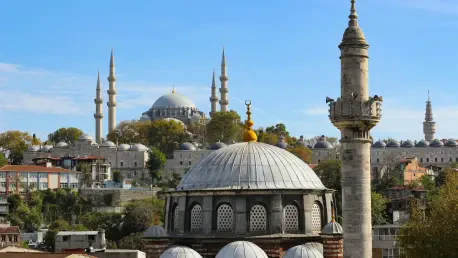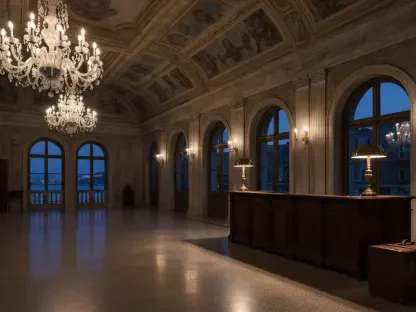The Middle East has swiftly emerged as a pivotal player on the global tourism stage, captivating travelers with its blend of ancient heritage and futuristic ambition, and as a region fueled by a youthful, digitally adept population and visionary national strategies, it is experiencing a travel boom that redefines expectations. From cutting-edge resorts to untapped cultural gems, the area is no longer just a brief layover but a destination in its own right. This article explores the dynamic shifts shaping the travel landscape, delving into economic surges, digital revolutions, and evolving traveler desires. Each trend reflects a broader transformation, positioning the Middle East as a hub of innovation and allure for a diverse array of visitors seeking both adventure and authenticity.
A striking aspect of this evolution is the seamless integration of tradition with modernity, creating experiences that resonate deeply with global audiences. Whether it’s wandering through historic souks or marveling at towering skyscrapers, the region offers a unique duality that captivates visitors. This balance is further enhanced by policies and technologies that make travel more accessible and personalized than ever before. As the Middle East continues to open its doors, the interplay of cultural immersion, luxury, and spontaneity is crafting a new narrative for tourism that promises to captivate for years to come.
Market Growth and Emerging Destinations
Booming Economies and New Hotspots
The travel sector in the Middle East is witnessing remarkable economic growth, with countries like the UAE and Saudi Arabia at the forefront of this surge. Data indicates that gross bookings in the region have soared past pre-pandemic figures, reaching impressive heights with a projected compound annual growth rate of 7% from 2025 to 2030. The UAE, particularly Dubai, remains a dominant force, handling millions of passengers annually through its world-class airport facilities. Meanwhile, Saudi Arabia’s ambitious Vision 2030 has catalyzed a dramatic rise in inbound visitors, transforming it into a major leisure destination. This economic momentum is not just about numbers; it reflects a broader shift where tourism is becoming a cornerstone of national development, driving job creation and infrastructure investment across the region.
Beyond the established giants, emerging destinations are adding fresh dimensions to the Middle East’s appeal, with countries like Oman carving a niche as a cultural and leisure haven through strategic partnerships with global tourism entities and plans for new hospitality projects in the coming years. Egypt is also experiencing a resurgence, bolstered by enhanced infrastructure that makes its ancient wonders more accessible to global travelers. Smaller nations like Jordan and Bahrain are steadily gaining attention with their unique offerings, from historic sites to modern leisure attractions. These rising stars are diversifying the region’s tourism portfolio, ensuring that there’s a destination suited to every traveler’s taste, whether seeking history or relaxation.
A key driver behind this growth is the youthful demographic eager to explore both within and beyond their borders, coupled with rising disposable incomes in key markets that are fueling demand for travel. Domestic tourism is seeing significant upticks as locals rediscover their own countries. At the same time, international interest is booming, drawn by iconic projects and cultural landmarks that promise unparalleled experiences. This dual demand is pushing governments and the private sector to align their strategies, investing heavily in airports, hotels, and transport networks. As a result, the Middle East is not only sustaining its growth but also setting new benchmarks for what a travel destination can offer in terms of scale and ambition.
Rising Stars and Untapped Potential
While certain hubs continue to dominate headlines, lesser-known locales are quietly positioning themselves as must-visit spots. Saudi Arabia’s Red Sea resorts and cultural treasures like AlUla are drawing global attention, blending natural beauty with historical significance in ways that captivate visitors. These developments are part of a broader push to showcase the country’s diversity beyond religious tourism, appealing to a wider audience. The focus on sustainable and regenerative designs in such projects also signals a commitment to preserving the environment while catering to modern traveler expectations, setting a precedent for other nations in the region to follow.
Equally compelling is the untapped potential in intra-regional travel, with airlines expanding routes to connect “backyard” destinations like Pakistan and Iraq, highlighting a growing curiosity for nearby yet underexplored areas. Despite geopolitical complexities, these connections underscore a rising interest in discovering hidden gems closer to home. Industry experts note that such expansions could unlock new markets, fostering cultural exchange and economic ties within the broader Middle Eastern sphere. This trend of looking closer to home for unique travel experiences is reshaping how the region is perceived, moving beyond traditional tourist circuits to embrace a more interconnected and adventurous approach to exploration.
Digital Transformation in Travel
Mobile-First Booking and Social Media Influence
The digital landscape is fundamentally altering how travel is planned and experienced in the Middle East, with mobile platforms leading the charge by offering innovative solutions for a seamless journey. Online and mobile bookings are projected to account for a substantial share of transactions, climbing significantly from 2025 onward. Travelers, especially Millennials and Gen Z, are increasingly relying on apps and messaging services for seamless trip planning, from flights to local activities. This mobile-first approach caters to a desire for instant access and convenience, allowing individuals to craft itineraries on the go with just a few taps, a trend that reflects the region’s tech-savvy demographic and rapid adoption of digital tools.
Social media platforms like Instagram, TikTok, and YouTube are no longer just sources of inspiration but powerful decision-making tools in the travel sphere. They shape perceptions and influence choices, with visually captivating content driving interest in specific destinations and experiences. Industry leaders observe that younger travelers often base their plans on trending posts or influencer recommendations, prioritizing destinations that offer photogenic backdrops or unique cultural moments. This shift underscores a broader move toward visual storytelling in marketing, where authentic, engaging content can turn a lesser-known spot into an overnight sensation, amplifying the region’s global visibility.
The immediacy of digital platforms also fuels a culture of spontaneity, with many opting for last-minute bookings for short-haul trips within the Gulf Cooperation Council. This behavior contrasts with the more deliberate planning seen among long-haul or family travelers, yet it highlights a growing demand for flexibility in travel arrangements. Cancellation policies and payment options are adapting to meet these needs, ensuring that even impulsive decisions can be made with confidence. As digital channels continue to evolve, they are not only streamlining processes but also redefining how travelers connect with the Middle East’s diverse offerings, making every journey more accessible and tailored.
AI and Technological Innovations
Artificial Intelligence is emerging as a transformative force in the Middle East’s travel industry, offering hyper-personalized recommendations that enhance user experiences and improve overall satisfaction. From suggesting destinations based on past searches to optimizing booking processes, AI tools are boosting efficiency and satisfaction for both travelers and providers. Companies are leveraging this technology to predict trends and tailor offerings, ensuring that suggestions align closely with individual preferences. This level of customization is particularly appealing in a region where diverse traveler segments—from luxury seekers to budget adventurers—demand unique and relevant options at every turn.
However, there’s a careful balance to maintain between technological advancements and the human element that defines travel. Industry voices emphasize that while AI excels in backend operations like data analysis and logistics, the emotional nuances of planning a journey often require a personal touch. Customer interactions, especially for complex or luxury itineraries, still benefit from human expertise to address specific needs and build trust. This dual approach ensures that technology serves as an enabler rather than a replacement, preserving the warmth and connection that make travel memorable in the Middle East’s culturally rich context.
Beyond AI, broader innovations are reshaping the region’s tourism infrastructure. Massive projects, including eco-friendly resorts and state-of-the-art airport expansions, are integrating cutting-edge designs to attract global visitors. These developments prioritize sustainability alongside convenience, reflecting a forward-thinking mindset that aligns with international standards. As technology continues to permeate every aspect of travel, from planning to on-the-ground experiences, the Middle East is positioning itself as a leader in innovation, ensuring that each visitor’s journey is as seamless as it is inspiring.
Evolving Traveler Preferences
Luxury Redefined and Experiential Focus
Luxury travel in the Middle East is undergoing a profound transformation, moving away from mere extravagance toward authenticity and exclusivity, as today’s high-end travelers seek experiences that offer a deeper connection to the region’s heritage, such as private desert retreats or bespoke cultural tours. Research shows a strong preference for arts and culture among visitors to countries like Saudi Arabia, Qatar, and the UAE, with many prioritizing immersive activities over traditional opulence. This shift reflects a desire for meaningful encounters, where luxury is defined by access to rare, authentic moments rather than just lavish accommodations or amenities.
This trend is further supported by platforms that curate unique offerings, from seasonal events to local culinary experiences that blend international and regional flavors. Resorts are also adapting, with concepts like nature-integrated luxury in Saudi Arabia’s desert landscapes gaining popularity for their innovative approach to blending environment and comfort. Such developments cater to a clientele that values privacy and personalization, ensuring that every aspect of their journey feels distinct. As a result, the definition of luxury in the Middle East is becoming synonymous with cultural depth and tailored experiences, setting a new standard for what premium travel can be.
The emphasis on experiential travel extends beyond the elite, influencing a broad spectrum of visitors who crave engagement with local traditions. Whether it’s participating in art festivals or exploring historical sites, travelers are drawn to activities that provide insight into the region’s storied past and vibrant present. This growing appetite for substance over surface is pushing tourism providers to rethink their offerings, focusing on storytelling and connection. The Middle East, with its rich tapestry of history and modernity, is uniquely positioned to meet these demands, crafting journeys that resonate on a personal and cultural level.
Spontaneity and Flexibility in Planning
A notable shift in traveler behavior across the Middle East is the rise of spontaneity, particularly among younger demographics who favor last-minute bookings and short getaways, a trend that is reshaping how vacations are planned. This trend is especially prevalent for intra-regional trips within the Gulf area, where quick weekend escapes are becoming the norm. Digital platforms facilitate this impulsiveness by offering real-time availability and flexible cancellation policies, allowing travelers to make decisions with minimal risk. The preference for adaptability reflects a broader cultural shift toward living in the moment, where rigid itineraries are giving way to more fluid, dynamic travel plans.
This demand for flexibility significantly shapes how travel companies structure their services, with an increasing focus on customizable packages that can be adjusted on short notice to meet diverse needs. Families and long-haul travelers, while still planning further in advance, are also seeking greater leeway in terms of payment options and itinerary changes. Data suggests that trip durations are lengthening, as visitors opt for more immersive stays rather than fleeting visits, a pattern driven by the desire to fully experience a destination. This evolving behavior challenges providers to balance efficiency with personalization, ensuring that even spontaneous travelers receive a curated and satisfying journey.
The implications of this trend are significant for the Middle East’s tourism ecosystem, as it necessitates agile responses from airlines, hotels, and tour operators. Marketing strategies are adapting to target these spontaneous adventurers with flash deals and targeted social media campaigns that capitalize on the urge to travel now. Meanwhile, the infrastructure supporting such travel—be it through enhanced digital interfaces or streamlined booking processes—continues to evolve. This focus on flexibility not only caters to current demands but also positions the region as a responsive and innovative player in the global travel market.
Policy and Regional Collaboration
Visa Reforms and Unified Tourism Initiatives
Policy changes are playing a pivotal role in enhancing the Middle East’s accessibility, with visa liberalization initiatives breaking down barriers for international and regional travelers alike. The introduction of programs like the GCC Grand Tours Visa enables seamless movement across multiple countries, including Bahrain, Kuwait, Oman, Qatar, Saudi Arabia, and the UAE. Such measures are transforming the region’s image from a mere transit hub into a cohesive, primary destination where visitors can explore diverse cultures and landscapes without bureaucratic hurdles. This unified approach is fostering a sense of shared identity among nations, amplifying their collective appeal on the global stage.
Specific reforms, such as Saudi Arabia’s relaxed entry rules for religious pilgrims, allow extended stays and broader exploration beyond traditional pilgrimage sites, significantly boosting tourism. This has spurred both inbound and domestic travel, with locals increasingly discovering their own country’s treasures at a notable annual growth rate. Streamlined processes for key source markets are also shifting perceptions, encouraging longer visits and repeat trips. These policy shifts are not just logistical adjustments; they represent a strategic vision to position the Middle East as an open, welcoming region that prioritizes traveler convenience while boosting economic contributions from tourism.
The impact of these initiatives extends to how the region markets itself internationally, with collaborative campaigns highlighting the diversity of experiences available across borders. Governments and tourism boards are working hand-in-hand to promote multi-destination itineraries, showcasing everything from urban sophistication to desert serenity. This synergy is evident in joint ventures and shared infrastructure projects that enhance connectivity, such as improved flight networks and cross-border transport links. As these efforts continue to mature, they are laying the groundwork for a more integrated tourism landscape, one that invites global visitors to see the Middle East as a singular, vibrant tapestry of destinations.
Strategic Partnerships and Infrastructure Growth
Regional collaboration is further strengthened by strategic partnerships that drive tourism growth through shared goals and resources, helping emerging markets like Oman elevate their profiles. Alliances with global travel companies are paving the way for new hotel developments and cultural initiatives set to roll out in the coming years. These partnerships not only bring in expertise and investment but also ensure that the region aligns with international standards, appealing to a wider audience. The focus on sustainable growth within these collaborations reflects a commitment to long-term viability, balancing economic gains with environmental stewardship.
Infrastructure development remains a cornerstone of these efforts, with massive investments in airports, transport systems, and eco-friendly resorts reshaping the travel experience in the Middle East. The UAE’s ongoing expansions of aviation hubs and Saudi Arabia’s futuristic projects like NEOM are prime examples of how physical advancements support tourism ambitions, demonstrating a commitment to innovation and growth. These projects are designed to handle increasing visitor volumes while offering cutting-edge amenities that enhance comfort and accessibility. Such developments signal to the world that the Middle East is prepared to meet the demands of modern travelers, from efficient transit to immersive destinations.
The ripple effects of these strategic moves are felt across the tourism value chain, from job creation to enhanced service quality. By aligning national visions with practical infrastructure growth, countries in the region are ensuring that their tourism sectors are not only competitive but also resilient. This forward-looking approach is crucial in a global market where traveler expectations are constantly evolving. As partnerships deepen and projects come to fruition, the Middle East stands poised to redefine what it means to be a leading travel destination, blending ambition with actionable progress.
Reflecting on a Transformative Era
Looking back, the Middle East’s travel sector demonstrated extraordinary dynamism, with economic surges, digital innovations, and policy reforms weaving together to create a robust tourism landscape. The rise of mobile-first booking platforms and AI-driven personalization reshaped how journeys were planned and experienced, while a focus on authentic luxury and cultural immersion captured the hearts of global visitors. Emerging destinations and regional collaborations broke new ground, turning the region into a unified, must-visit hub. These milestones underscored a period of reinvention, where tradition met modernity in unforgettable ways.
As the industry moves forward, the emphasis should shift toward sustaining this momentum through continued investment in sustainable practices and traveler-centric technologies, while balancing digital advancements with the human touch to maintain the emotional resonance of travel. Additionally, nurturing intra-regional connections and promoting lesser-known locales can further diversify the region’s appeal. By focusing on these actionable steps, the Middle East can solidify its standing as a global leader, ensuring that its tourism narrative continues to evolve with creativity and purpose for years ahead.









